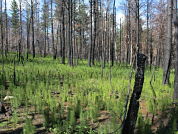Non-native conifer plantations in Patagonia: risks of planting without proper management
DOI:
https://doi.org/10.25260/EA.16.25.2.0.153Abstract
In the last decade in Patagonia, a significant number of research studies evaluated the environmental impact of plantations and analyzed the modes of production in order to increase the yield and reduce its impact. While plantations provide benefits for regional economies, at the present the extent of this contribution is unclear. Furthermore, there are several environmental problems produced by plantations, with the invasions of adjacent ecosystems being one of the most damaging impacts in the long term. Another problem related to the plantations, although still incipient in the region, is the increment of forest wildfires. Plantations accumulate large amounts of dry and flammable fuel, particularly when they are not properly managed. Also many species or varieties of Pinaceae are adapted to fire, so they could not only change the regime and type of fires, but also display positive feedbacks causing high social, economic and ecological costs. We believe that these problems could be minimized to a great extent with the application of good forestry practices.References
Armstrong, AJ & HJ Van Hensbergen. 1996. Impacts of afforestation with pines on assemblages of native biota in South Africa. South African Forestry Journal, 17:35-42.
Caccia, FD & CL Ballaré. 1998. Effects of tree cover, understory vegetation, and litter on regeneration of Douglas-fir (Pseudotsuga menziesii) in southwestern Argentina. Canadian Journal of Forest Research-Revue Canadienne De Recherche Forestiere, 28:683-692.
Davel, M. 2008. Estimación de la productividad de sitio. Pp. 30-42 en: Davel, M (ed.). Establecimiento y manejo del pino oregón en Patagonia. Esquel, Argentina: CIEFAP.
Jobbágy, EG; AM Acosta & MD Nosetto. 2013. Rendimiento hídrico en cuencas primarias bajo pastizales y plantaciones de pino de las sierras de Córdoba (Argentina). Ecol. Austral, 23:87-96.
Keeley, JE & WJ Bond. 1997. Convergent seed germination in South African fynbos and Californian chaparral. Plant Ecol., 133:153-167.
Loguercio, GA & F Dececchis. 2006a. Forestaciones en la Patagonia Andina: potencial y desarrollo alcanzado. Parte 1. Patagonia Forestal, 1:4-8.
Núñez, MA & E Raffaele. 2007. Changes due to afforestation on post fire regeneration in native shrubland communities in Northwestern Patagonia, Argentina. J. Veg. Sci., 18:827-834.
Núñez, MA; A Moretti & D Simberloff. 2011. Propagule pressure hypothesis not supported by an 80-year experiment on woody species invasion. Oikos, 120:1311-1316.
Orellana, I & E Raffaele. 2010. The spread of the exotic conifer Pseudotsuga menziesii in Austrocedrus chilensis forests and shrublands in northwestern Patagonia, Argentina. New Zealand of Forestry Science, 40:199-209.
Pausas, J. 2012. Incendios Forestales. CSIC y Libros de la Catarata. España.
Pausas, J; G Alessio; B Moreira & G Corcobado. 2012. Fires enhance flammability in Ulex parviflorus. New Phytol., 193:18-23.
Peña, E & A Pauchard. 2001. Coníferas introducidas en áreas protegidas: un riesgo para la biodiversidad. Bosque Nativo, 30:3-7.
Richardson, DM & SI Higgins. 1998. Pines as invaders in the southern hemisphere. En: Richardson, DM (ed.). Ecology & Biogeography of Pinus. Cambridge University Press.
Richardson, D. 1998. Forestry trees as invasive aliens. Conserv. Biol., 12:18-26.
Sarasola, MM; VE Rusch; TM Schlichter & CM Ghersa. 2006. Invasión de coníferas forestales en áreas de estepa y bosques de ciprés de la cordillera en la Región Andino Patagónica. Ecol. Aust., 16(2):143-156.
Schlichter, T & P Laclau. 1998. Ecotono estepa-bosque y plantaciones forestales en la Patagonia. Ecol. Aust., 8:285-296.
Simberloff, D; MA Relva & MA Núñez. 2002. Gringos en el bosque: introduced tree invasion in a native Nothofagus/ Austrocedurs forest. Biol. Invasions, 4:35-53.
Simberloff, D; MA Relva & MA Núñez. 2003. Introduced Species and Management of a Nothofagus/Austrocedrus Forest. Environ. Manage., 31:263-275.
Simberloff, D; MA Núñez; NJ Ledgard; A Pauchard; D Richardson; et al. 2010. Spread and impact of introduced conifers in South America: Lessons from other southern hemisphere regions. Austral Ecol., 35:489-504.

Downloads
Published
How to Cite
Issue
Section
License
Copyright (c) 2015 Estela Raffaele, Martín Núñez, María Relva

This work is licensed under a Creative Commons Attribution 3.0 Unported License.
Authors retain their rights as follows: 1) by granting the journal the right to its first publication, and 2) by registering the published article with a Creative Commons Attribution License (CC-BY 4.0), which allows authors and third parties to view and use it as long as they clearly mention its origin (citation or reference, including authorship and first publication in this journal). Authors can make other non-exclusive distribution agreements as long as they clearly indicate their origin and are encouraged to widely share and disseminate the published version of their work.


